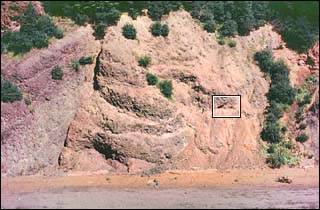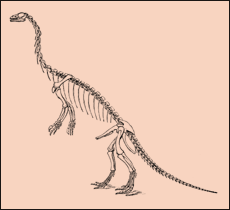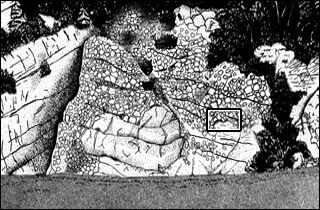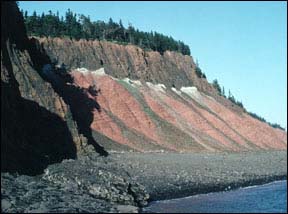 |
 |
| Outcrop in Nova Scotia, Canada of the McCoy Brook Formation of Early Jurassic age in which a dinosaur skeleton was found (box) | Reconstruction by O. C. Marsh of type of dinosaur (Anchisaurus sp.) found on left. |
 |
 |
| Outcrop in Nova Scotia, Canada of the McCoy Brook Formation of Early Jurassic age in which a dinosaur skeleton was found (box) | Reconstruction by O. C. Marsh of type of dinosaur (Anchisaurus sp.) found on left. |
You could make up stories.SCIENCE IS BASICALLY A CONVERSATION WITH NATURE
But how to decide which is right?First, we all agree that we are going to make a scientific study. What does that mean?
In Science we make up explanatory stories and try to make generalizations.
Science differs from all other human activities in that there is an external source of judgment:Correspondence to reality
Scientific hypotheses have TESTABILITY.
Differs from religion because precepts can be changed and must be at least potentially subject to external judgment. Differs from art because we agree there is only one explanation, one valid interpretation.Consider a painting (in this case by Artemisia Gentileschi) of Judith slaying Holofernes (1597?-after 1651)
Many equally valid interpretations are possible of this painting - and you may feel many equally valid emotions.
Literary criticism, Poetry, and Music interpretation, are similar.Law - Rule of conduct and persuasion, no necessary correspondence to reality.So what makes science different is that it is constantly tested against correspondence to reality.
Of course, motivation of participants is complex and may have little to do with results of science.
The Grand Canyon There are three basic fields: These principles go back to the 17th century.
"The head of a shark dissected"
Glossopetrae or "tongue stones" were found scattered along some layers in the mountains around Tuscany. They were in fact found imbedded within stone. Steno did a detailed description of a sharks head and reasoned that the Glossopetrae were in fact the teeth of sharks that had lived when the mountains were under water.This second work was:This lead him to his second work which was of great power, and dealt with the question of how did a solid body (such as the sharks tooth) get within another solid body (i.e. rock)?
"The prodromus of Nicolaus Steno's dissertation concerning a solid body enclosed by a process of nature within a solid"THIS WORK WAS THE FOUNDATION OF OUR UNDERSTANDING OF READING THE ROCK RECORD
Steno postulated 4 principles of stratigraphy1. Principle of superposition of strata2. Principle of initial horizontality of strata
3. Principle of stratal continuity
4. Principle of cross cutting relationships
ALL ABOUT INFERRING TIME FROM GEOMETRY
This had a big effect in Great Britain where the next major advance was made.
Lived from 1726-1797: during a time when natural phenomena were being explained by natural causes.Observed unconformities, and believed in cycles.
Proposed the Rock Cycle
EXPLAINED EARTH'S NATURAL PHENOMENA BY NATURAL CAUSES WHICH HE COULD SEE OPERATING TODAY
Led to what we call:THE PRINCIPLE OF UNIFORMITARIANISM - REVELED IN THE CONCEPT OF DEEP TIME
He viewed the Earth and Earth history as having, "no vestige of a beginning, no prospect of an end."
Age of canal building - Smith was a canal engineer.20 years of intense work by geologists in Europe and North America ordered rock sequences and resulted in the naming of most "time periods".Discovered that different rock formations contain distinct fossil assemblages and that even isolated areas of rocks could be identified in their sequence by the fossils they contained.
Made a map of England published in 1814-1815
Strata identified by organized fossils 1816-1819
Principle of Biotic Succession
Allowed rocks in disparate areas to be ordered.
Very strong uniformitarian.Felt that magnitude of processes had not changed.
Earth must be very old.
All the big changes in Earth History were all due to the sum of small effects.
Applied Lyellian Uniformitarianism to organisms.WE NOW BASICALLY USE SIMILARITY IN THE FOSSIL ASSEMBLAGES TO INFER PROXIMITY IN TIME.Insensibly graded series - evolution by natural selection.
Origin of species - 1859.
VAST AMOUNTS OF TIME NEEDED.
EXPLAINED WHY PRINCIPLE OF BIOTIC SUCCESSION WORKS.
Not the kinds of fossils present (e.g. shells vs. teeth, but rather the specific species of plants or animals present.ALONG WITH STENO'S PRINCIPLES OF STRATIGRAPHY, THIS HAS ALLOWED THE RELATIVE ORDER TO BE ESTABLISHEDFor example: Ammonites - restricted to Late Paleozoic and Mesozoic.
One particular species (Psiloceras planorbis) is known only from rocks of early Jurassic age.
CONSTANT TESTING AND RETESTING OF CONSISTENCY
You could use sedimentation rates:Determine the amount of sediment being delivered to the sea by rivers. Calculate how this one year's worth of sediment would be spread over the ocean floors and use that rate (thickness of 1 year's sediment / 1 year). Then use this to convert the thickness of rock strata from thickness to years.You could do a similar calculation with the saltiness of the ocean. (e-mail me some suggestion on how to do this!)[ thickness / ((thickness of 1 year's sediment) / 1 year)) ]
What do you think some of the problems with this would be? (e-mail me some answers!)
Sun is hot now, how long will it remain so:1855 - 20-25 my for the right temperature for organisms to exist.
Also similar estimates for age of Earth from cooling from a molten ball.
Most geologists and especially paleontologists suffer from "physics envy" and are susceptible to bludgeoning by math and physics wielded by a strong physicist such as Kelvin.In Kelvin's 1868 address on geological time he did just that and kept a lot of geologists from following the idea that the Earth was very very ancient.
"Is present knowledge relevant to the behavior of matter under such extraordinary conditions as obtain in the interior of the sun sufficiently exhaustive to warrant the assertion that no unrecognized sources of heat reside there? What the internal composition of the atoms may be is as yet an open question. Is it not improbable that they are complex organizations and the seats of enormous energies? ...No cautious chemist would probably venture to assert that the component atomecules, to use a convenient phrase, may not have the energies of rotation, revolution, position and be otherwise comparable to those of a planetary system. Nor would he probably be prepared to affirm or deny that the extraordinary conditions which reside in the center of the sun may not set free a portion of this energy."
1896 - Henri Becquerel discovers radioactivity - acts like x-rays discovered by Röntgen and darkens photographic plate.From then to now, many thousands of dates by many methods.1902 - Ernest Rutherford and Fredrick Soddy framed atomic disintegration theory:
"the atoms of radioactive bodies are unstable and a certain fixed proportion of them become unstable every second and break up with explosive violence, accompanied in general by the expulsion of an alpha- or beta-particle. The residue of the atom, in consequence the loss of an a-particle, is lighter than before and becomes the atom of a new substance quite distinct in chemical and physical properties from its parent."1904 - Rutherford described how heat of Earth and Sun could be accounted for by radioactive decay(alpha-particles are helium atoms and beta-particles are electrons)
1905 - Bertram Boltwood, Yale, U-Pb, and John William Strutt (with Ra-He) dated various "old rocks and got ages of 400 to 2000 million years".
1911- 1927 - Arthur Holmes, U-Pb, U-He methods produced the first calibrated geological time scale.
1. When a crystal of a mineral forms it starts with some amount of a radioactive element.Should be no confusion: radiometric dating works on the same principles as nuclear weapons and is based on the same basic theory - contra creationists2. As the "parent" radioactive element decays, the "daughter" element stays locked within the crystal.
3. No "extra" of the daughter-type element can be present.
4. The decay rates of the element must be known.5. Then the ratio of daughter to parent can be used to calculate the age of the formation of the crystal.
I know its difficult to remember, but here are some acronyms that will help you.
 |
 |
| Outcrop in Nova Scotia, Canada of the McCoy Brook Formation of Early Jurassic age in which a dinosaur skeleton was found (box) | Drawing of the outcrop on left, emphasizing layering. |
Layering in sandstone (a) tilted - must have been more extensive. Lava flow (b) all busted up and abutting sandstone which drapes over it. Sandstone must be younger than basalt.What was the environment that produced the sandstone?PRINCIPLE OF STRATAL CONTINUITY
PRINCIPLE OF ORIGINAL HORIZONTALITY
PRINCIPLE OF UNIFORMITARIANISM
Dinosaur in sands which look like dune sands, in detail - probably are fossil dunes produced in a desert.What is the rubbly rock that looks like it is made of basalt boulders and sandstone (c)?
Sands contain blocks of basalt arranged as talus cones - probably are fossil talus cones.What of the animal itself?PRINCIPLE OF UNIFORMITARIANISM
Turns out to be a prosauropod dinosaur, probably Anchisaurus - known elsewhere in the world only in rocks of Late Triassic and Early Jurassic age of the Mesozoic -What is found nearby associated with the lava flow?PRINCIPLE OF BIOTIC SUCCESSION

In the lava flow itself:Using the 40K-40AR decay scheme the age of the lava flow is about 200,000,000 years old - consistent with ages throughout to be around the Triassic-Jurassic boundary (193-213 million years ago)Just below that is a gray layer containing the fossil pollen of plants:APPLICATION OF RADIOMETRIC DATING
Compares well with the pollen in marine rocks in England and Germany in rocks which contain many marine fossils (including Psiloceras planorbis) correlating with the Early Jurassic in the Jura mountainsBelow that are other gray layers with pollen of rather different composition comparable to what is found in the prosauropod beds themselves in the type Triassic age rocks in Germany.PRINCIPLE OF BIOTIC SUCCESSION
PRINCIPLE OF BIOTIC SUCCESSIONThus, we would conclude that the rocks deposited around the prosauropod bones are younger than the lava flow and the Triassic-Jurassic transition -PRINCIPLE OF SUPERPOSITIONWE MIGHT MAKE OTHER PREDICTIONS OF WHAT WE SHOULD FIND: OTHER REPTILES, NO TRIASSIC TYPES, OTHER RADIOMETRIC SYSTEMS AGREEING ETC.Test, TEST AGAIN, adjust.
Go To Lecture 3
RETURN TO THE SYLLABUS
Return to the Dinosaurs 1997 home page
send comments and questions to : polsen@ldeo.columbia.edu